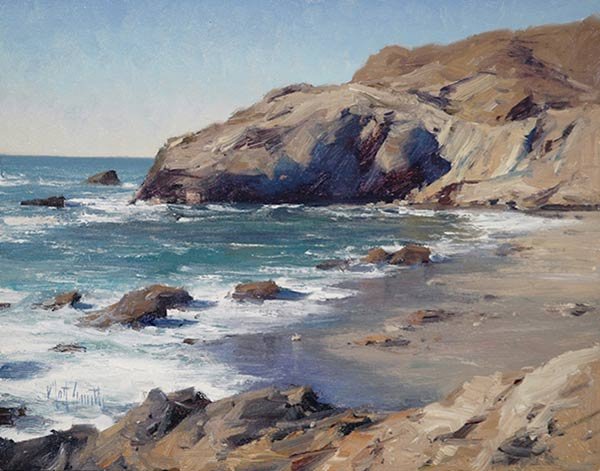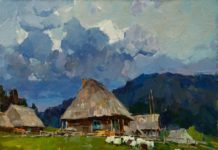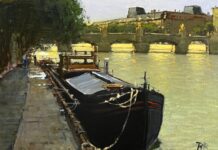World-renowned master plein air painter Matt Smith will be conducting a special 1 1/2-day pre-convention workshop starting on April 14, the day before PleinAir magazine’s Plein Air Convention & Expo (PACE) begins. Smith is not only one of the most respected painters in the landscape painting world, he has reached superstar status, and his work is selling alongside the finest masters at the very top art shows and galleries. He is a brilliant teacher, and he will teach attendees his entire painting process, start to finish, and explain the thinking behind it.
Smith has devoted his life to excellence as a painter. He has studied with the finest masters, and will walk attendees through the processes he learned from these masters, allowing attendees to bring excellence into their own paintings.
“This is a really big deal, to get Matt,” says Eric Rhoads, publisher of PleinAir magazine. “I honestly believe that 1 1/2 days with Matt before the convention will make even the best, most experienced painters stronger. Matt tells me that many well known painters have studied with him and found that their eyes were opened to new things they had never discovered on their own.”
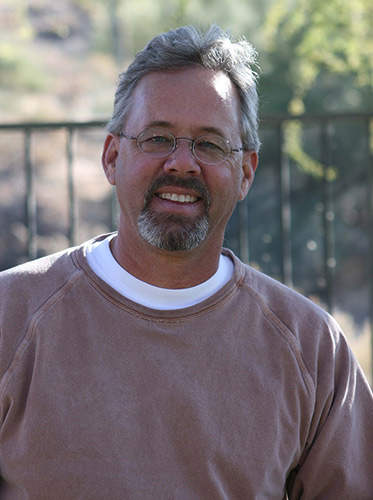
Matt Smith
The pre-convention workshop is $197 and is available only to Plein Air Convention attendees.
To learn more, visit www.pleinairconvention.com
Smith believes that many painters, even experienced painters, can realize dramatic improvement in their work by continuing to focus on the fundamentals of drawing, value, design, and color. Understanding these four basics will help you dramatically in analyzing the foundational structure of your subject, which will in turn enable you to see as an artist, as opposed to just a painter. By breaking these things down to their individual elements, then building from there, you will gain a more thorough understanding of how they relate structurally to the individual components of a chosen subject.
He will begin with drawing, the most important of the fundamentals. By reducing drawing to its two basic components, proportion and perspective, and explaining how they work, he’ll give you a greater understanding of the difference between line and form and how they can both be used to build a painting.
Next comes value, which is often discounted in favor of color. Smith says, “The truth is that it is absolutely important to see value first and understand how it can be used to create design, form, and a stronger feeling of light in your work.”
He goes on, “Just by understanding drawing and value, I can intellectually insert information where I visually do not see it. An example of this relates to the plant life here in the Arizona desert. It is often so thin and wispy that one tree morphs into another, creating an overall uninteresting flat shape. By establishing accurate color and value and building forms within one or two trees in the mass, the entire shape becomes more interesting and ‘believable.’”
He will go on to discuss design and many of the elements that can make a painting more interesting. These include selecting a compelling motif, applying it to the proper format, and deciding where to put dominant elements within a given format. He’ll explain how to use the other three fundamentals as a means to create a more interesting composition. Balance, line quality, value contrast, color both contrasting and complementary, texture, edges, calligraphy, and overall surface quality will also be reviewed.
Finally, Smith will discuss color and how it can be misunderstood. “Color is the only one of the four fundamentals that can be eliminated without compromising the artistic quality of the work of art,” he says. If you’re unsure of this, look at some of the early black-and-white illustrations of Frederick Remington, Carl Rungius, William Herbert Dunton, and the like, which Matt will show on slides. These were often masterful works.
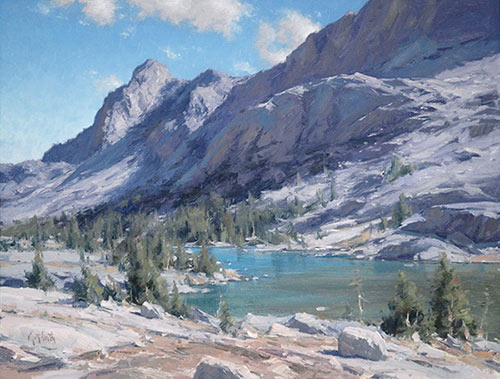
“Sailor Lake,” by Matt Smith
That doesn’t mean color should be discounted. It is the most personal of the four fundamentals, giving it a unique importance. By understanding the four basic principles of color — hue, value, intensity, and temperature — you will gain an increased grasp of color and how it can work to your advantage. For example, understanding these basic properties when analyzing color in the field can dramatically help with your color accuracy.
Additionally, Smith will discuss the importance of light and how to capture the look and feel of natural light that is unique to outdoor painting. He’ll discuss direct light, reflected light, and reflected sky light, and how and when they affect your subject. “I believe strongly that if you want to understand the intensity of light within a given subject, you need to look into the shadows,” he says. “The stronger the light source, the stronger the reflected light is that is primarily found in the shadows. We will also discuss intensity, direction, temperature of light, and how they can affect the subject.”
Smith will do onstage demonstrations, which you’ll be able to see close up or projected on the big screen. He will also offer a few critiques and answer questions from those in attendance.
Matt Smith’s Pre-Convention Workshop will be held April 14 and half day April 15. Plein Air Convention & Expo opens the afternoon of April 15. It’s only available to registered plein air convention delegates. Space is limited. Please register today. For more information, visit the Plein Air Convention & Expo’s website.

